



Suggested citation: Agrawal, Shalu, Sunil Mani, Dhruvak Aggarwal, Abhishek Jain, Chetna Hareesh Kumar and Karthik Ganesan. 2020. Awareness and Adoption of Energy Efficiency in Indian Homes: Insights from the India Residential Energy consumption Survey (IRES) 2020. New Delhi: Council on Energy, Environment and Water.
This study assesses the impact of the existing energy efficiency initiatives on household awareness levels, preferences and behaviour concerning efficiency in electricity use. It examines the level of awareness of Indian households about Bureau of Energy Efficiency’s (BEE) star labelling program, the benefits they associate with it, and the key parameters that determine their appliance purchase decisions. Further, the study proposes strategies to accelerate the energy-efficiency transition in India’s residential sector.
The study is based on the India Residential Energy consumption Survey (IRES) - the first-ever pan-India survey on the state of energy access, consumption and energy efficiency in Indian homes. It covers nearly 15,000 households in 1210 villages and 614 wards in 152 districts across 21 states. Conducted in 2019 in collaboration with the Initiative for Sustainable Energy Policy (ISEP), the survey findings help make comparisons with the progress made since ACCESS2018 and ACCESS2015.
One-fifth of rural and two-fifths of urban households are aware of BEE star label
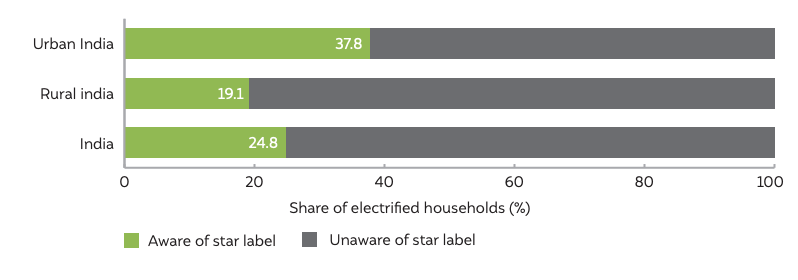
Source: Author's analysis
More than 80 per cent households in all except three central states use LED lamps for lighting
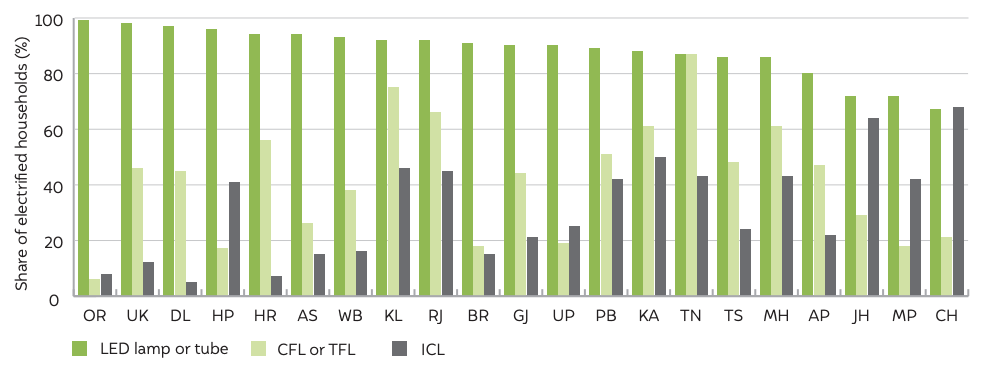
Source: Author's analysis
Note: The sum of shares is more than 100 due to the use of multiple lighting types in many homes
Most households consider appliance cost as the most important parameter, but some also value energy savings
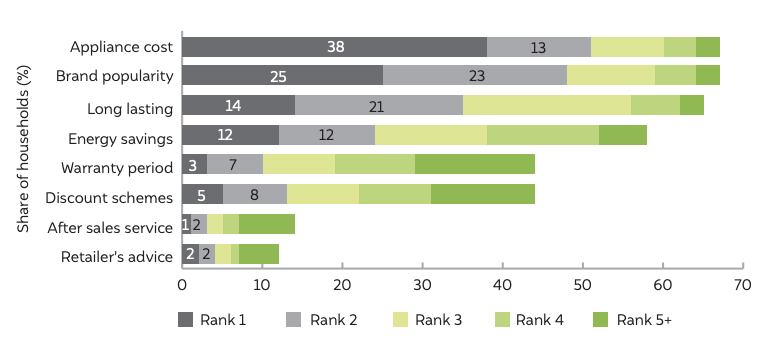
Source: Author's analysis
Electricity use in Indian homes accounts for a quarter of the country’s total electricity consumption and has been growing steadily over the past two decades (MoSPI 2019). With rising incomes, the residential electricity consumption in India is projected to at least double over the next decade. Energy efficiency can play a crucial role in addressing the energy trilemma of our times—providing affordable, reliable, and sustainable energy for all. The Bureau of Energy Efficiency (BEE) has been pushing for energy efficiency in homes through initiatives such as the standards & labelling (S&L) programme, consumer awareness campaigns, and market transformation initiatives.
However, not all Indian states have made equal progress in their pursuit of energy efficiency. A lack of outcome-based indicators hinders the comprehensive assessment of consumers’ behavioural response to policy interventions. Many independent consumer surveys conducted in different states have assessed household awareness about energy efficiency initiatives in recent years, but these studies have represented very small geographical areas or strata of the population. A large-scale assessment using a geographically and socioeconomically representative sample is needed to draw reliable inferences about the state of energy efficiency in Indian households.
Realising the need to assess the impact of existing energy efficiency initiatives on household awareness levels, preferences, and behaviour concerning efficiency in electricity use, we have undertaken a first of its kind, nationally representative survey of nearly 15,000 households across 21 states of India. We call this the India Residential Energy Survey (IRES), which was conducted in collaboration with the Initiative for Sustainable Energy Policy (ISEP). IRES covers different dimensions of electricity and cooking energy use in households. In this report, we answer the following questions:
i. How aware are Indian households about BEE’s star label? Which consumer categories and states would require more attention going forward?
ii. What appliances do Indian households run using electricity? What share of those appliances are energy-efficient?
iii. What influences appliance purchase decisions of Indian households? What role can appliance financing play in nudging consumers towards more efficient products?
Based on our research and findings, we propose strategies to accelerate the energy-efficiency transition in India’s residential sector.
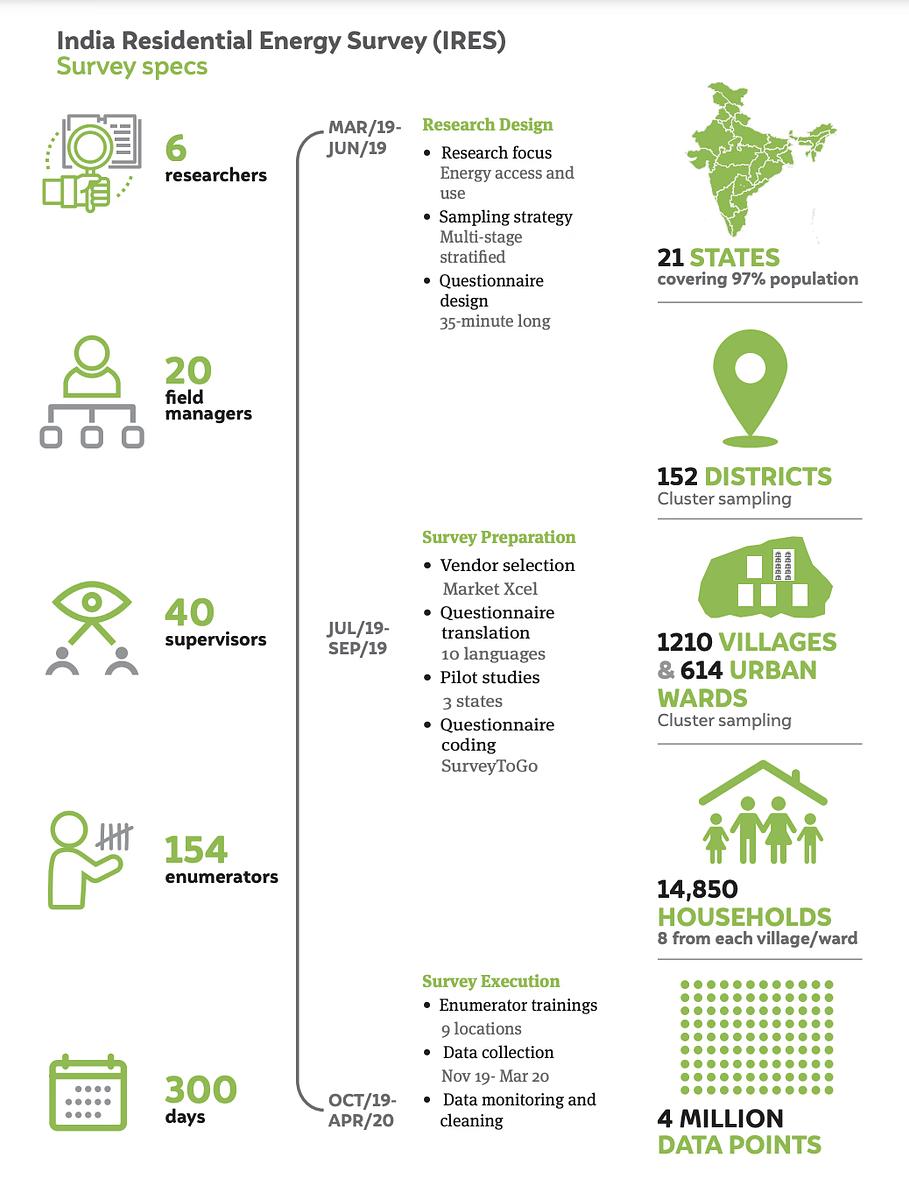
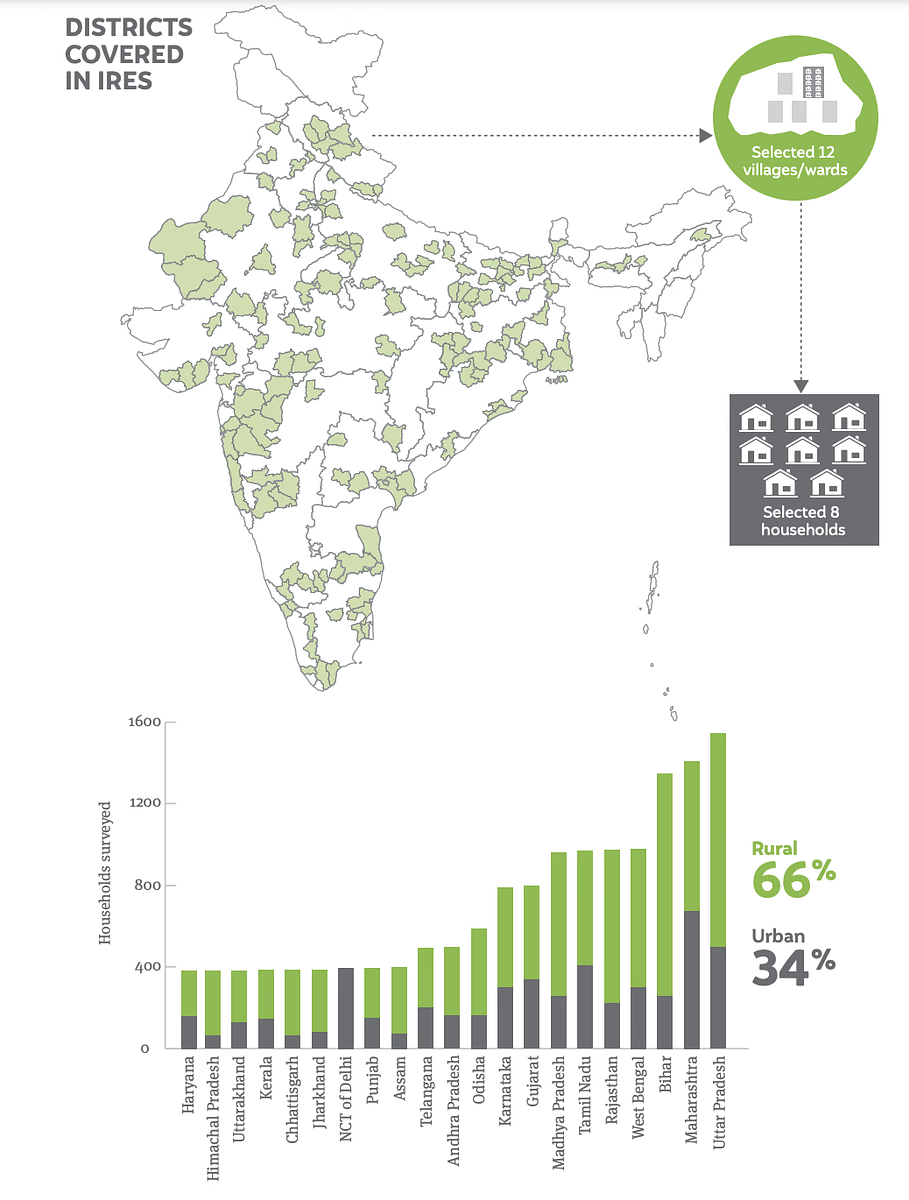
As per IRES, one in four Indian households is aware of BEE’s star label. The BEE launched the S&L programme in May 2006 to “provide the consumer an informed choice about the energy saving and thereby the cost saving potential of the relevant marketed product” (BEE 2020). The larger objective of the programme is to nudge the Indian market towards energy-efficient products by creating awareness among consumers through media campaigns, celebrity endorsements, and engaging with students.
After almost a decade and a half since the launch of S&L programme, only a quarter of the electrified Indian households have heard of star labels. The awareness is relatively lower among rural population (Figure ES1). States with richer, more urban population, more educated households, and higher ownership of appliances covered under mandatory scheme typically have higher awareness levels (Figure ES2). Going forward, the focus of awareness campaigns needs to shift to smaller towns and rural areas, as households in these areas are expected to add more appliances in future.
Figure ES1 One-fifth of rural and two-fifths of urban households are aware of BEE star label

Source: Authors’ analysis
Figure ES2 States with more urban, richer, and educated consumers have higher awareness levels about BEE star label
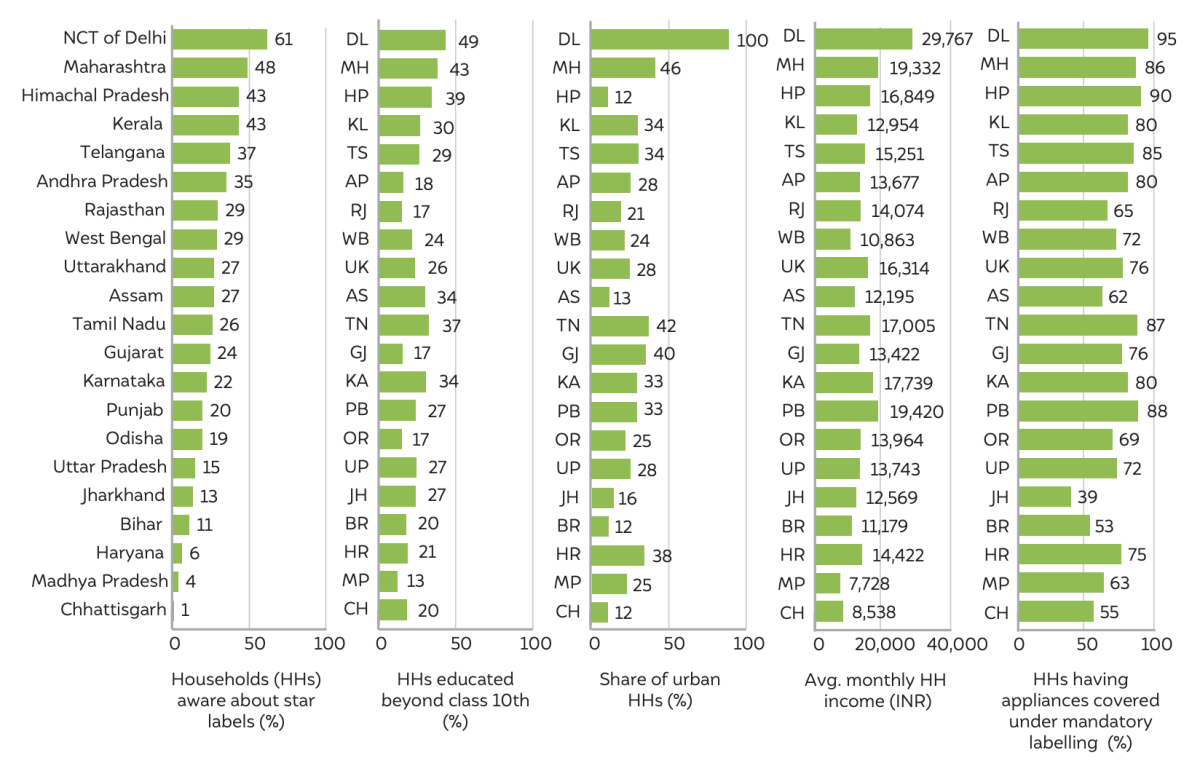
Source: Authors’ analysis
The UJALA scheme has brought energy-efficient LEDs to almost every Indian home. Until recently, energy-inefficient incandescent lamps (ICL) were mainly used for lighting in Indian homes. To promote efficient lighting solutions, the Government of India launched the Unnat Jyoti by Affordable LEDs for All (UJALA) scheme in 2015. Under a demand-aggregation model, Energy Efficiency Services Limited (EESL) distributed light-emitting diode (LED) lamps to households at significantly lower price than the prevailing market rate by lowering the LED cost through bulk procurement.
As per our survey, nearly 90 per cent of Indian homes now have switched to LED lamps. Moreover, two-thirds of the total lighting stock of 1 billion lamps and tubes in Indian homes is now LED-based. The share of households using LED lamps is highest in Odisha followed by Delhi, Uttarakhand, and Himachal Pradesh, mainly due to proactive government schemes. Jharkhand, Madhya Pradesh, and Chhattisgarh have the lowest share of households adopting LEDs (Figure ES3). Overall, 9 per cent of urban and 14 per cent of rural households in India do not use any LED light, mainly due to lack of awareness about LED lamps and their relatively higher upfront cost.
Figure ES3 More than 80 per cent households in all except three central states use LED lamps for lighting

Source: Authors’ analysis
Note: The sum of shares is more than 100 due to the use of multiple lighting types in many homes.
India has made significant progress in adopting energy efficient ACs and refrigerators. After lighting, fans, televisions (TVs) and refrigerators are the most common electric appliances in Indian homes (Table ES1). These are followed by mixer-grinders, electric iron, coolers, immersion rods, washing machine, water geysers, laptops, and air-conditioners (ACs). Of these, four appliances (AC, TV, geyser and refrigerator) fall under BEE’s mandatory labelling scheme, two (fans and washing machine) are under the voluntary scheme, and laptops come under endorsement scheme. The remaining appliances are currently out of the ambit of S&L programme.
We find that more than 75 per cent of AC users have star-labelled ACs, which reflects the positive impact of mandatory labelling scheme on one of the most energy-intensive household appliances. However, one-sixth of the AC users do not know about the star labels on their ACs. Adoption of labelled refrigerators and awareness about the labels is lower in comparison to ACs. We also found that 15 per cent of refrigerators in use were more than ten years old (bought before implementation of the refrigerator labelling scheme). We also observe presence of unlabelled refrigerators among newer purchases, which may reflect second-hand buys or availability of unlabelled products in some markets.
We also find that there is an increasing shift towards energy-efficient liquid crystal display (LCD) and LED TVs. However, two-thirds of TV users still have cathode-ray tube (CRT) models. Among other appliances, we find a moderate progress in adoption of energyefficient geysers and washing machines, which were respectively brought under mandatory and voluntary labelling since 2016 and 2018.
The adoption of energy-efficient ceiling fans, however, remains dismal, which could be due to their relatively higher cost and limited availability in the market. Ceiling fans, which make up a major portion of residential electricity use, are under the voluntary programme since 2009. Thus, voluntary scheme has had limited impact on nudging the market towards higher efficiency fans.
Table ES1 Ownership and efficiency levels for key appliances used in Indian homes
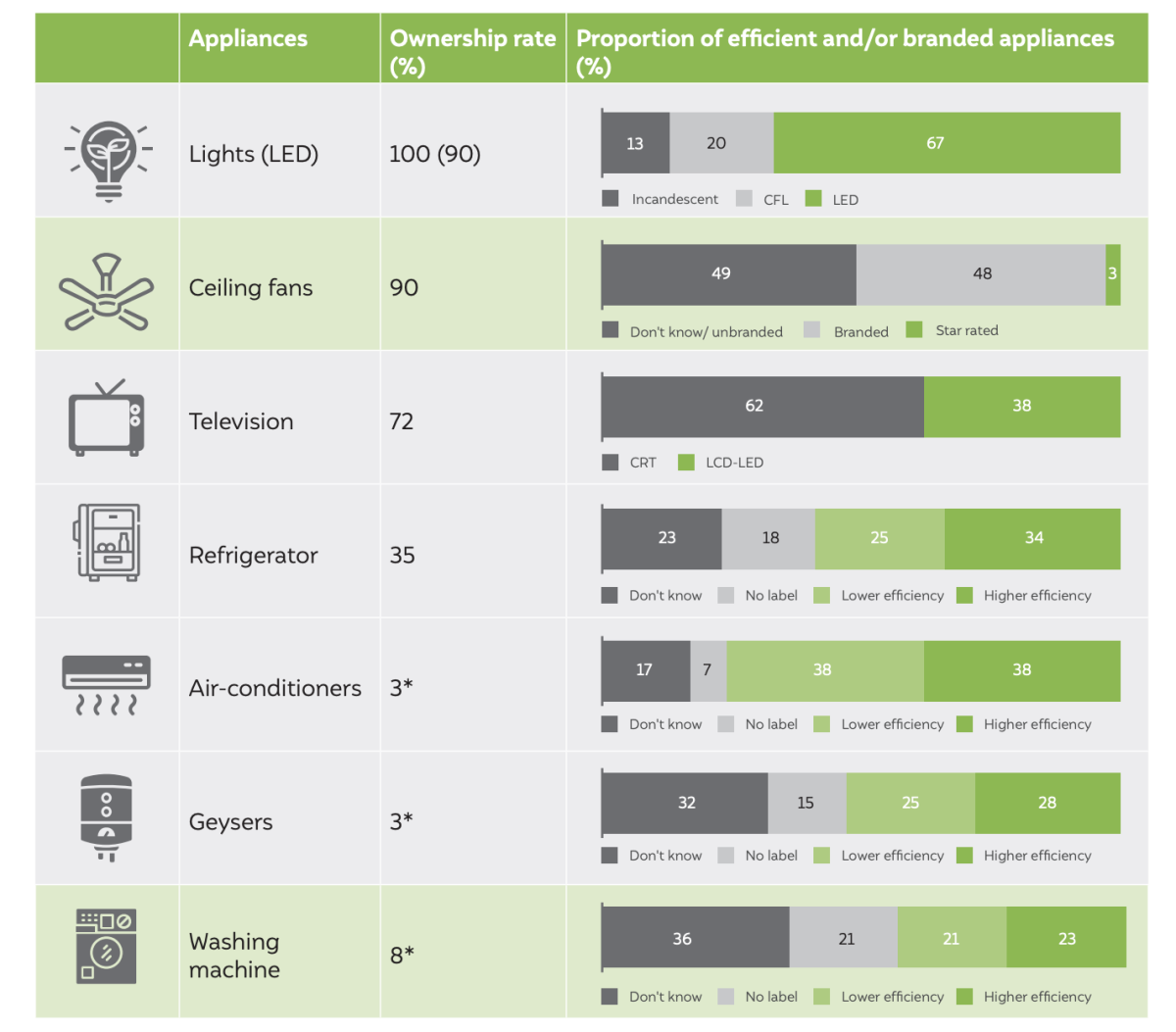
Source: Authors’ analysis
Note: The graph for lights displays the composition of total lighting stock. Remaining graphs display efficiency and/or make-up of most-used appliances in the surveyed households. Appliances in grey background have mandatory labelling; those in green have voluntary labelling.
* These estimates are conservative due to high non-response rate in more urban and economically better-off districts.
Appliance purchase behaviour reflects households’ preference for low-cost models. In our survey, 40 per cent of the households ranked appliance cost as the most important factor in their purchase decision, followed by other parameters such as brand popularity, durability, and energy savings. Price sensitivity further dominates purchase decisions in rural households and those belonging to lower economic strata. Making energy-efficient appliances affordable through bulk procurements, advance market commitments, or enduser financing is therefore the need of the hour to drive adoption of efficient appliances.
As per our survey, only four per cent of the households have used financing for appliance purchase. However, there is a high untapped demand for home appliance financing in India, as nearly one-sixth of the households expressed interest in buying appliances on credit and a higher share of low-income households want to exercise this option (Figure ES4). Refrigerators and TVs are most popular consumer durables that people would like to buy with appliance financing, followed by space cooling appliances.
Figure ES4 Aspiration for appliance-related credit is higher among lower income households
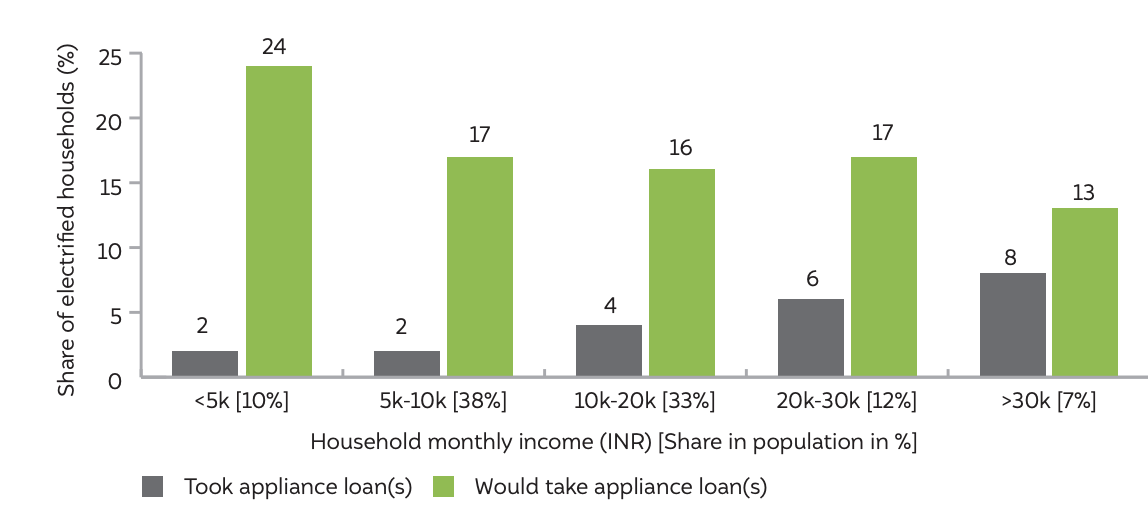
Source: Authors’ analysis
Household’s appliance use patterns are far from those advocated for energy savings. Energy savings are realised not only by purchasing energy-efficient equipment but also through energy conservation behaviour. We observed that among AC-owning households:
So, consumer education is necessary to apprise them of optimising AC energy use through periodic servicing, by optimal temperature setting, and using fan with ACs as appropriate.
The choice of higher efficiency models, entailing higher investment, depends upon frequency and duration of equipment use. For instance, one-third of washing machine owners use it only once a week, while one-fourth use it for more than four times a week. However, we do not observe any variation in the choice of star-labelled washing machine among households with different use frequency. Both retailers and consumers should be made aware of including appliance usage frequency in their purchase decisions for consumers to make informed choices.
Recognising the role that energy efficiency can play, India was an early mover in the framing of the Energy Conservation (Act) at the turn of the century. BEE, a product of the same legislation, has been at the forefront of formulating approaches to deliver energy efficiency at scale for various sectors of the economy. BEE’s focus on appliances used within households has certainly yielded benefits. India has seen significant adoption of efficient technologies, particularly those covered under mandatory labelling programme. Based on the study’s findings, we make the following suggestions to further energy efficiency in the residential sector.
Design an aggressive, consumer-centric, and decentralised consumer awareness strategy
Low awareness levels about BEE star label highlight the need for year-round and sustained awareness campaigns, in regional languages and through diverse media, to capture the attention of consumers in smaller towns and rural areas. For this purpose, it would be helpful to leverage local institutions such as gram panchayats in rural areas, residents’ welfare associations and municipal councils in urban areas, and grassroots organisations.
Given their regular touch-point with consumers, power distribution companies (discoms) should take the lead in initiatives on consumer awareness, drawing inspiration from other discoms that are already active in the energy efficiency campaigns. For instance, discoms in Maharashtra provide energy-saving tips on their bills and a discom in Delhi is sending ‘home energy reports’ to consumers as part of a pilot study. As most consumers rely on word-of-mouth, BEE could consider a pilot programme to identify and train local ‘champions of energy efficiency’ to lead the campaign on energy efficiency among the local community.
Improve the market availability of energy-efficient products by bringing more residential-use appliances within the fold of mandatory S&L scheme
Our study confirms the stronger influence of the mandatory labelling programme in ensuring greater adoption of the energy-efficient appliances. However, developing and enforcing a mandatory labelling programme is a resource-intensive exercise. BEE needs to continuously evaluate and identify key appliances driving residential electricity demand through a robust mechanism.
The voluntary programme for ceiling fans, which contribute a major share to household electricity use, has achieved negligible success. To make energyefficient fans part of Indian households, BEE plans to bring them under mandatory labelling from 2022. India’s fans market is highly unorganised and BEE should, therefore, engage with and support the industry associations of small-scale manufacturers to bring them under the ambit of the mandatory scheme without jeopardising their business prospects. Further, a strict enforcement of the minimum performance standards would ensure the removal of unlabelled or spurious products from the market.
Make energy-efficient appliances affordable
Enforcement of minimum standards often raises the appliance cost. This is mainly a concern for appliances used for meeting basic domestic needs, such as fans, because a majority of Indian consumers tend to be price-sensitive.
Innovative business models, such as demand aggregation as in case of LED lamps, are required to bring down the cost of energy-efficient products for other uses, particularly ceiling fans. EESL has recently partnered with discoms in Delhi to facilitate the adoption of energy-efficient ACs through a dedicated e-commerce platform (EESL mart). Discoms must explore similar approaches for diverse products as part of their demand-side management strategy. Discoms could also consider on-bill financing programmes under which consumers pay for the energy-efficient appliance purchase through their utility bills. However, pilot studies are needed to design suitable business models and test consumer response to such interventions.
Our study highlights the inclination of consumers for availing credit for home appliance purchases. Interestingly, top brands are found to influence the choice of appliances (second only to the cost of appliances). Credit purchase of appliances provides an excellent opportunity for industry leaders to coordinate with key stakeholders such as discoms and demand aggregators and shift the market towards efficient and affordable appliances. Further, BEE could incentivise financial institutions that extend loans on consumer appliances to encourage these institutions to provide more favourable loan terms—such as longer tenure or lower interest rate—for the purchase of energyefficient products.

Enabling a Circular Economy in India’s Solar Industry

Community Solar for Advancing Power Sector Reforms and the Net-Zero Goals

Mapping India’s Residential Rooftop Solar PotentialA bottom-up assessment using primary data

Promoting the Use of LPG for Household Cooking in Developing Countries